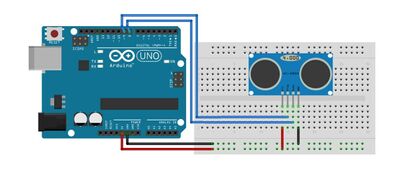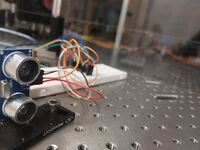Ultrasonic Acoustic Remote Sensing
Acoustic Sensing: Background & Trivia
Sound waves can be used to sense the environment. This technique has been developed in nature and in our technology.
In Nature
This technique is broadly coined by the term "Echolocation" to describe its variants in different species. Some examples:
- Bats
- Bats echolocate with a frequency of 11-212kHz with most operating between 20-60kHz (Jones & Holderied, 2007).
- Cetaceans (Whales & Dolphins)
- Chong et. al. (2021) performed an experiment to test the ability of dolphins to decipher objects of various materials (but otherwise identical) with their biosonar. In their experiment, their bottlenose dolphin, Ginsan, produced frequencies in the range of 50kHz-130kHz.
- Shews
- Shrews echolocate with a frequency of 30-60kHz (Thomas & Jalili, 2004). According to Chai et. al (2020), genome data suggests that bats, cetaceans and shews experience convergent evolution, sharing the same set of genes for this skill.
In Technology
This technique is employed by different types of technology, such as in SONAR or in Seismic Inversion.
- SONAR
- SONAR is used primarily in underwater related work. Aside from military uses popularized in popular culture, SONAR is used for the study of shipwrecks (Deep Sea Archaelogy). They employ frequencies of up to 600kHz for high resolution sensing or down to 1kHz for deep sensing (Soreide, 2011).
- Seismic Inversion
- Seismic Inversion refers to the use of sound to extract layers of the earth. This is used by geophysicists in environmental remote sensing to understand the rock composition of the region for general purposes or to locate minerals or oil and gas (Chen et. al, 2017). The source of the sound could be actively caused via explosives or passively recorded via external sources such as traffic noise (Dou et. al, 2017). The frequency of such waves can be as low as 0.6-37Hz (Dou et. al, 2017).
Fundamental Principle & Additional Principles
The most basic principle behind this technique rely on round trip Time-Of-Flight (TOF) measurements of reflected sound waves. However, more complicated principles can be involved. For example:
- In Seismic Inversion (oversimplified), one considers a delayed response composed of multiple reflections of waves propagating through a geologic medium to reconstruct structural layers.
- In Echolocation, bats use Doppler Shifts to locate moving targets.
Project Overview
In this project, we will use sound to sense the environment. From the previous section, it is clear that the use of sound in remote sensing can be quite varied from up to 600kHz down to 0.6Hz. Therefore, we should start by defining the scope of the project.
Scope & Justification
In this project, we will use sound in the ultrasonic range (>20kHz) for remote sensing.
- Ultrasonic sound operates beyond the range of human hearing which is ideal for non-intrusive remote sensing
- Ultrasonic sound is more directional because the propagation of the sound waves follows the physics of diffraction.
Objectives
Tools
On the most basic level to run our experiment, we require a source of ultrasonic sound, a receiver sensitive to ultrasonic wavelengths, and a board to control these devices. Arduino provides a convenient solution these requirements.
- . Arduino UNO R3
- . HC-SR04 Ultrasonic Emitter/Sensor
Theory
Distance Measurement (Experiment 1)
Hardware


We connect the HC-SR04, which serves as the source and receiver, to the Arduino UNO R3 based on the above described circuit. From left to right of the HC-SR04: VCC-5V, Echo-pin 10, Trigger-pin 9, Ground-Ground. This completes the hardware of the set-up.

Software
Results
Analysis/Reflection on Experiment
To better understand this part of the experiment, it is important to know the characteristics of the HC-SR04.
References
Jones, G., & Holderied, M. W. (2007). Bat echolocation calls: adaptation and convergent evolution. Proceedings. Biological sciences, 274(1612), 905–912. https://doi.org/10.1098/rspb.2006.0200
Wei, C., Hoffmann-Kuhnt, M., Au, W.W.L. et al. (2021). Possible limitations of dolphin echolocation: a simulation study based on a cross-modal matching experiment. Sci Rep 11, 6689. https://doi.org/10.1038/s41598-021-85063-2
Thomas, J. A., Moss, C., & Vater, M. (2004). Review of echolocation in insectivores and rodents. In Echolocation in bats and Dolphins. essay, University of Chicago Press. https://www.researchgate.net/publication/258835904_Review_of_echolocation_in_insectivores_and_rodents
Chai, S., Tian, R., Rong, X., Li, G., Chen, B., Ren, W., Xu, S. & Yang, G. (2020). Evidence of Echolocation in the Common Shrew from Molecular Convergence with Other Echolocating Mammals. Zoological Studies 59: 4. https://doi:10.6620/ZS.2020.59-4
Chen, Y., Chen, H., Xiang, Kui., Chen, X. (2017). "Geological structure guided well log interpolation for high-fidelity full waveform inversion". Geophysical Journal International. 209 (1): 21–31. doi:10.1093/gji/ggw343
Dou, S., Lindsey, N., Wagner, A.M. et al. Distributed Acoustic Sensing for Seismic Monitoring of The Near Surface: A Traffic-Noise Interferometry Case Study. Sci Rep 7, 11620 (2017). https://doi.org/10.1038/s41598-017-11986-4